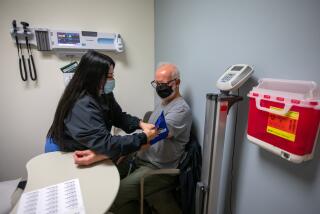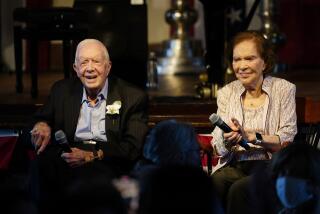Column: To Grace Lopez with love — and apologies that your end wasn’t better
Several times in the last few years my family headed up to the Bay Area thinking it would be the last chance to see my mother alive.
She had a bum heart and kidney disease, and she’d get confused in the middle of a sentence, like a hiker lost in a heavy fog. She had said many times since the death of my father seven years ago that she wanted to die, and there were days she didn’t get out of bed.
Over the recent holidays, it became clear the end was near. She took a fall, went to the hospital in a state of delirium and refused to eat. A feeding tube was suggested, but in her advance healthcare directive, my mother had declined any life-extending medical procedures. And she checked a box that said this:
“I direct that treatment for alleviation of pain or discomfort be provided at all times, even if it hastens my death.”
She was frail as a leaf in the hospital, and when her eyes were open, she didn’t know her three children. I thought she’d die in the hospital, but on a Thursday evening, my brother and sister and I were told our mother would be discharged to hospice as soon as possible.
In our rapidly aging country, more than a million older Americans receive hospice care each year. It’s covered by Medicare, and hospitals often recommend it when they know death is near and have nothing left to offer.
In retrospect, we could have done some advance research, but like a lot of families, we hadn’t and so had to scramble, making quick decisions at a time we were already overwhelmed and trying to keep grief at bay.
One of my mother’s doctors recommended a particular hospice agency, so we met with its representative at the hospital, I asked about staffing, because my father was in hospice care at home, and we were shocked by how spotty the service was. When nurses failed to show up, we were told that holiday staffing was a problem.
The hospice rep expressed surprise that we’d had such an experience. The moment my mother left the hospital she’d be in the care of the hospice medical team, the rep said, and a care plan would be drawn up. My mother would see a nurse three times a week, more if needed, and home health aides would also make visits.
My mother’s doctor recommended against hospice at home, partly because my mother was agitated and aggressive in her state of delirium, and partly because my sister has health issues of her own. She’s amazingly capable, but ovarian cancer metastasized to her brain many years ago. After several surgeries, she’s doing well, but the illness has taken a toll.
The hospice agency doesn’t find the care facility for you, so we used a broker to tell us what was available in Contra Costa County.
On Friday morning at the hospital, the push for discharge was stepped up. Two doctors said my mother didn’t need the level of care provided by a hospital, and it was time to move on. They said she might last another seven to 10 days. As the hospital prepared the discharge papers, my sister and I drove to a private home with several hospice beds in eastern Contra Costa to see if we had a good feeling about the place.
It’s not easy to make a decision like this. We were in a stranger’s home. The place where our mother would die.
But the owner, a woman named Esther, struck us as caring and straightforward. As she walked us through the home, she knew each patient by first name, and she knew something about their life stories. Esther showed us an available bedroom, with good natural light, and through the sliding door, we could see a bird feeder like the one my mother had outside her kitchen. The price was $200 a night, and we agreed.
I had to return home briefly, but that night I asked my sister how things were going.
“It’s horrible,” she said.
The agency had delivered a bed to Esther’s home. But when my mother arrived a few hours later, she was in distress, writhing, resisting, moaning. Esther’s attendants suggested they might have to send my mother somewhere else. They had expected a sedated patient, with meds, and an initial evaluation by the hospice nurse.
My sister tried frantically, for hours, to calm my mother while the attendants called the hospice agency repeatedly. But they couldn’t get a good read on what had gone wrong or when a nurse might arrive.
My parents were the children of immigrants. They clipped coupons, preferred used cars to new ones, bartered over prices and often remarked at restaurants that my mother could have made the same dish, only better, for a fraction of the cost. Especially if it was Italian food. When my father began fading, he took many falls but never wanted to pay for an ambulance ride. One night, he fell and couldn’t get up, and my mother got down on the floor next to him and pulled a blanket over them.
With my mom, it was all about family. She took care of her father when he was ill, then my dad, and she wanted nothing more than for her three kids to be comfortable, cared for and loved. Now it was our turn, and we wanted her to die peacefully, with as little pain and discomfort as possible. That is supposed to be the goal of hospice, too.
When more than five hours had passed, I got hold of a nurse who told me she was at an all-night pharmacy. There’d been a complication getting the right meds, and the nurse assigned to my mother was with another patient. She told me the agency had failed my mother, and she was sorry, but she was doing her best to remedy the situation. Friday discharges could be complicated, she said.
First of all, that’s unacceptable, and if it’s really the case, why the rush to discharge her? Shouldn’t the hospice and hospital have coordinated the handoff? It’s hard not to think the obvious — that in this case, as in so many areas of healthcare, money drives medical decisions, and patients sometimes suffer the consequences.
A nurse turned up with the medication, roughly six hours after my mother had arrived at the home, but my mother remained restless through much of the night. It wasn’t until the next morning that another nurse arrived to do a full assessment, and the pain management still wasn’t working.
A supervisor apologized to me and said her team would investigate what had gone wrong and get back to me, but nobody did. So we fired that agency, signed a contract with another one, and finally, five days after my mother’s initial discharge, her pain and discomfort were brought under control.
By the way, the attendants at the home my mother was taken to did a terrific job of caring for her. And generally speaking, I think hospice nurses do difficult tasks with great skill and compassion. One of them, a nurse for 28 years who tended my mother gently, told me she considers hospice work a privilege.
The nurse explained that impending death is signaled by changes in body temperature, heart rate, breathing patterns, darkening urine and the mottling of skin. She leaned down one day, put her face close to my mother’s, and told me she could sometimes smell when death was near. She believed my mother had a couple more days, and she was right.
This past Tuesday, at 3:10 p.m., Grace Lopez died peacefully with my sister and brother at her side. She was six weeks shy of her 90th birthday.
I don’t think it would be appropriate for me to name the hospice agencies involved because I wasn’t interacting with them as a journalist. And I should note that I believe in hospice care. This form of end-of-life care began several decades ago as a small nonprofit enterprise and social movement designed to allow terminally ill patients to unplug the wires and tubes and die peacefully in non-hospital settings.
Today, with support from Medicare and with an aging boomer population, it has grown into a multibillion-dollar, mostly for-profit industry, with huge national corporations dominating. Medicare now writes roughly $17 billion a year in checks to hospice agencies.
But recent years have seen a spate of massive Medicare billing-fraud cases against hospice agencies, and last year, the federal Office of the Inspector General released the results of an industry probe that found evidence of shoddy care, billing for services never provided and enrolling patients not eligible for hospice care.
“A hospice is paid for every day a beneficiary is in its care, regardless of the quantity or quality of services provided on that day,” said a summary of the report.
It also said “beneficiaries and their families and caregivers do not receive crucial information to make informed decisions about their care.”
One of the most damning conclusions was this:
“In some cases, hospices were not able to effectively manage symptoms or medications, leaving beneficiaries in unnecessary pain for many days.”
I encourage you to share your own hospice experiences with me. I’ve been talking to local and national authorities about the strengths and weaknesses of hospice care and about their recommended reforms, and I’ll have more on that in coming weeks.
In my mother’s memory, it’s the least I can do.
Get more of Steve Lopez’s work and follow him on Twitter @LATstevelopez
More to Read
Sign up for Essential California
The most important California stories and recommendations in your inbox every morning.
You may occasionally receive promotional content from the Los Angeles Times.











